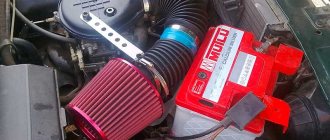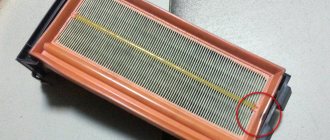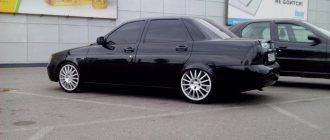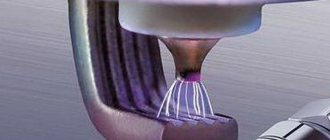Hi all! Next up we have a fairly relevant and interesting topic. After all, we will talk about the zerovik filter. Many people have heard about such an air filter, but not everyone knows exactly what it is, what it is needed for and what use it is.
The nulevik is installed instead of the air filter in its normal place. And here it is important to understand what such a device provides. I’ll say right away that there are pros and cons to it. But for the sake of objectivity, I will first try to tell you in detail about the device, and then sum up whether there is any benefit in this purchase, whether it is worth installing a nulevik on a car, on a moped, on some VAZ or on a carburetor, for example. After all, there are very often craftsmen on the Internet who install a device for Pidburg on Alpha, that is, on a scooter.
Don't forget to share your opinion. Especially if you have personal experience in using zero resistance filters. This is exactly what it is correct to call zeros.
Why is this necessary?
First, let's figure out what it is and what it is eaten with. A standard or regular air filter is designed to clean the air entering the engine from all kinds of contaminants. It is due to air filtration that power loss occurs.
This is due to the fact that the cleaning elements in the filter design (usually special paper) create resistance to air flow. This is not surprising since the filtration material is very dense. And the higher the resistance, the more the final power is lost. As you know, increasing power is achieved by increasing the amount of incoming air. This is where the zero impedance filter comes into play.
Nulevik is an alternative to the standard cleaner. Its design is such that the device reduces intake resistance without sacrificing air purification itself. This results in an increase in power.
And here a logical question arises: is your Priora, VAZ 2112 or VAZ 2114 worthy of such an element? Is it even worth buying a zero car if you want to slightly increase engine power?
Practice and research show that such a small tuning as installing a zero level allows you to get an increase of 3-5% in power. If this is a low-power car, then you definitely won’t feel an increase of several horsepower. You also won't see any difference in dynamics. But the numbers will be higher than you can comfort yourself a little.
Key Benefits
Reading reviews about nuleviks, I came across many conflicting opinions. One installed such a filter on his injector and was very pleased. Another spent a lot of money on a K&N zero and its installation, wanted changes, but in the end all he got was wasted time. And there are many such examples.
I’ll say right away that ordering zero-resistance filters from auto stores is not a problem at all. The price for some models is quite reasonable, so it is not difficult to buy and is relatively inexpensive. But whether such an element needs to be installed on a VAZ with your own hands is an extremely interesting question.
Let's start with the good. Like any device, the Nulevik has its pros and cons. The disadvantages include the cost compared to a conventional air filter and the need for constant cleaning.
As for the advantages, there are several of them.
- Power increases. The nulevik has a complex design that allows it to reduce resistance. This gives an increase in horsepower;
- Simultaneous cleaning efficiency. Although the resistance drops, this does not affect the quality of air purification;
- Replacement frequency. There is no need to change the nulevik as often as a regular filter. They are washable. This allows you to return full performance characteristics;
- Increase in characteristics. Albeit a little, but the zero gear adds power and increases torque;
- Sound. For many, it is not the power that is important, but the sound characteristic of powerful engines. Nulevik creates such an effect, and as a result the car sounds very interesting.
Types of zero resistance filters
Today, the automotive industry offers only two types of zero-resistance air filters:
- With impregnation. The most common and effective option. Adds up to 7% power, cleans the air flow well. Among the disadvantages are the frequent need for maintenance and replacement of the oil composition.
- Dry. Visually similar to a standard paper filter, but gives up to a 5% increase in power thanks to the cotton filling. It does not require constant fluid replacement, but, as practice shows, it is actually less effective.
Many manufacturers supplement the configuration of cleaning elements with their own developments and improvements. You need to determine the best manufacturer for yourself based not on the contents of the instructions and good advertising, but on the capabilities and needs of the car.
But there is a point
There is a common misconception that by removing the filter and housing you can significantly increase engine power. This is completely untrue.
It is important to take into account that when developing an engine, a careful calculation of the valve timing is made, which takes into account errors and losses on the filter. And if dust starts to enter the engine, it will definitely not be able to work for a long time. Here it is necessary to have a fence that will prevent the penetration of contaminants. Resistance can be reduced by widening the passage holes. But then the quality of filtration will decrease.
Before looking for a product code and buying a zero for your motorcycle or car, remember one simple truth. For cars without a powerful sports engine, the cost of purchasing such a filter will be absolutely pointless. You will only waste several thousand rubles. The only thing you will get is a slightly changed engine sound.
Nuleviks are only suitable for sports cars and cars with powerful power plants. The use of such a filter on serial engines is allowed only in cases where a comprehensive modification is carried out. That is, boring is done in the cylinders, an enlarged throttle valve is mounted, sports camshafts are installed, etc. You can also put a zero in the kit with them.
What is a zero resistance filter for?
There is an opinion that such a filter is a filter with zero resistance. Even despite the good performance indicators of the filter elements of this design, the attitude towards their installation cannot be called unambiguous. Many car enthusiasts note the fact that after replacing a conventional element with a filter with zero resistance, no changes were noticed.
Figure 1. Zero Resistance Cone Air Filter
On one of the sites I came across an article, it is given below, which talks about all the advantages of such filters and states their usefulness.
Service issue
If you decide to install a zero filter instead of a standard type air filter, then you will have to take extra care of it. The essence of care is cleaning and periodic impregnation with solutions. Moreover, during care, a certain technology is strictly observed.
If you don’t do this, your car’s fuel consumption will increase significantly, power will drop, and the car will begin to react poorly to increased speed when you press the gas pedal.
- remove the filter;
- clean dirt with a soft brush;
- remove dirt from the seat;
- rinse the filter with water;
- shake several times rather than dry;
- apply cleaning agent on both sides;
- install in place.
If the car is operated in fairly harsh conditions, then such preventive maintenance is carried out at least every 8 thousand kilometers. For normal conditions, 10-12 thousand km is enough. One zero can be washed up to 20 times. Then a mandatory replacement.
What can be said about such zero-resistance filters? They look impressive in the photo, are expensive and, in theory, have important advantages over standard filters. But when applied to production cars they are useless. It is a fact.
It is important to install nuleviks on powerful sports engines and engines that are subject to serious technical tuning. The filter itself will not improve the weather on engines whose power does not exceed 120-150 horsepower.
What are the advantages of zero?
- First of all, the filter gives an increase in power. Especially if it is installed together with some other modifications to the engine or exhaust;
- Due to the fact that a large volume of air passes through the nulevik, fuel consumption is reduced.
- It is easy to install in a regular place, there is no need to redo anything.
- It can be replaced after 10–15 thousand kilometers, just like standard filters.
- The engine compartment is pleasantly modified, giving the car a more sporty look.
Cold intake/inlet pipes (9)
The purpose of the standard intake filter of a VAZ car and other cars is to supply atmospheric air purified from impurities and mechanical particles into the engine combustion chamber.
But despite the fact that the standard filter performs its task well, due to its dense structure it makes it difficult for a certain amount of air to enter the combustion chamber, which in turn does not allow increasing the amount of the fuel-air mixture and thereby increasing the pressure on the piston (which We ultimately achieve an increase in power). To reduce these losses, a so-called zero-resistance filter (ZRF) was created.
This section presents low (zero) resistance filters, which are designed to increase the throughput of the entire vehicle intake.
An increase in throughput leads to an increase in the amount of air in the air-fuel mixture, and accordingly, with more air, the combustion process is more efficient, which increases engine power.
In our online store Stingershop you can buy zeros for both carburetor and injection cars.
Carburetor filters differ in that their mounting points are designed to be installed on top of the carburetor, while injection filters have an inlet for docking with the inlet pipe.
How does a zero resistance filter differ from a regular filter?
Standard filters are made from compressed paper fibers, and air masses penetrate through micro-holes in the structure of the material. Once the abrasive particles clog the penetrating holes, a “surface loading” phenomenon occurs. The air flow “looks” for another way to get inside, since the surface of the filter element has high resistance. In this case, engine power will decrease and fuel consumption will increase exorbitantly.
According to minimum cleaning standards, the material for standard filters must be rigid and the fibers must be compressed as much as possible, which is why paper filters have a higher resistance by default.
The zero-resistance filter design uses cotton fabric that is sandwiched between an aluminum screen. Fabric fibers are impregnated with special oil. As a result, dust particles are retained on the fibers and become part of the filter assembly, which triggers a new cleaning scheme. This system allows you to increase the working area of the element approximately five times and allow additional air flow to pass through.
How to properly maintain
Zero resistance filter maintenance sequence:
- cleaning with a special brush (you can use a soft clothing brush, you can additionally use a vacuum cleaner);
- washing the filter (you can use special compounds, even household “Laska” is suitable);
- drying for 12 hours (not close to the battery);
- application of special impregnation for FNS on the air inlet side - twice.
Do not exceed the amount of impregnation, as excess may enter the engine. The packaging of the Federal Tax Service and care products must contain instructions for use and operation. For some filter models, the maintenance sequence may be different.
Installing a zero resistance filter on a car
If, after watching the video, you still want to test the effectiveness of filters with zero resistance from your own experience, then proceed as follows. First, remove the filter housing itself. Then remove the section with the mass air flow sensor. After this, the zero-resistance filter is attached using clamps to the section with the mass air flow sensor, and the entire structure is attached to the air flow intake pipe.
The filter should be carefully secured to prevent it from loosening.
Special kits are available for sale, both for mounting the filter on any car, and for installation on a specific model.











